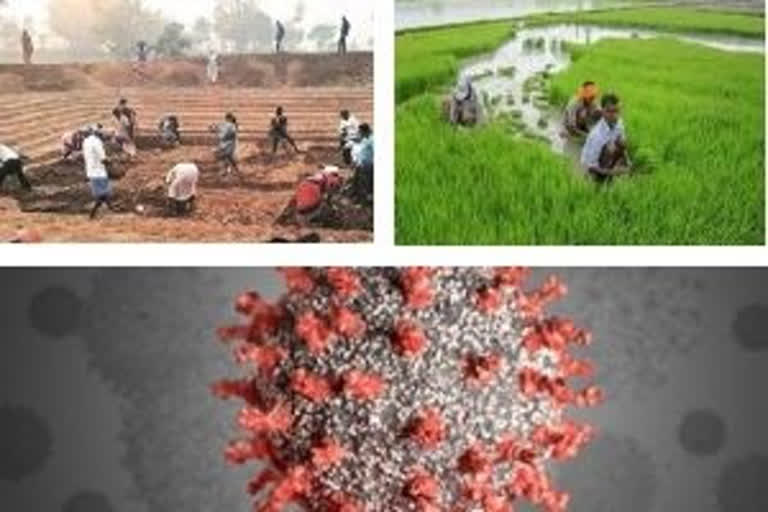New Delhi: This independence day will be quite unusual for India. The coronavirus is still spreading in the country. Similar to rest of the world, the pandemic affected both lives and livelihoods.
The economic shock is much more severe in India, for two reasons. First, the economy in pre-covid-19 was already slowing down from 8.1% in Q4 of 2017-18 to 3.1% in Q4 of 2019-20 compounding existing problems of unemployment, low incomes, rural distress, and widespread inequality. Second, India’s large informal sector is particularly vulnerable.
There has been an unprecedented shock to the labour market due to the pandemic. The lockdown has choked almost all economic activity. But the worst affected are the bottom of the pyramid particularly the migrants workers. The pandemic has led to widespread losses in jobs and incomes for informal workers. Unemployment has increased from 8.4% in March to 27% in April and May, 2020. There was a loss of 122 million jobs. Out of that, the small traders and casual labourers (daily wage labourers) lost 91 million jobs.
The unlock process since June in several parts of the country improved the economy and livelihoods to some extent but some other parts of India are still under lockdown. The duration and spread of the pandemic is still uncertain. The performance of rural economy is important as around 70 per cent of the total population and workforce reside in rural areas. Increase in their purchasing power is crucial for creating demand for goods and services of the entire economy.
Also read:SC to resume on Aug 18 hearing on pleas to cancel final term exams amid pandemic
The adverse impact of Covid-19 on rural areas is much lower than urban areas. There are also reports that rural economy is reviving after lockdown. It is true that the only saving grace for the Indian economy now is the performance of agricultural sector. In FY 21, agricultural GDP is expected to grow at 2.5 to 3 per cent although GDP for the overall economy may contract by 5 to 8 per cent. India is likely to have bumper crop in both Kharif and Rabi seasons due to normal monsoon. However, bumper crops can lead to fall in farm prices. Supply chain problems have to be solved for getting higher prices for farmers.
Moreover, agriculture sector is only one part of the story in rural areas. The non-farm sector has been increasing over time. The demand for FMCG, tractors and two wheelers rose in rural areas. However, this rural revival is overstated as it is a pent up demand after full lockdown. This demand may not be sustainable over time due to low remittances, low rural wages and incomes.
Around 40 to 50 million migrants have gone back to rural areas as part of the reverse migration. Employment has to be provided to these migrants and other rural workers. Public works can be used as a safety net for workers. In India, from the fourth Century BC when the ancient Indian political economist, Kautilya, wrote his Arthasastra, there has been emphasis on public relief works. Mahatma Gandhi National Rural Employment Guarantee Scheme (MGNREGA) can be a saviour for these workers during the Covid-19 period. MGNREGA also has secondary benefits such as creation of assets for agriculture and rural development; more participation of women; helping the marginalized sections; reducing distress migration; involvement of panchayats etc. A study done by the Indira Gandhi Institute of Development Research on assets created in Maharashtra shows 87% of the works exist and function and over 75% of these are directly or indirectly related to agriculture under NREGA. An overwhelming 90% of respondents considered the works very useful or somewhat useful.
The demand for MGNREGA soars in recent months amidst lockdown and job losses. Nearly 170 crore person days were created during April to 1st week of August, 2020 as compared to the 265 crores created in the entire year of 2019-20. In other words, around 64% of the last year person days were created in just few months this year because of demand. In the last 3 and half months, Telangana and Andhra Pradesh generated 106% and 96% mandays respectively as compared to the work done in 365 days in 2019-20. The progress of NREGA has repeatedly confirmed that villagers have been flocking to the scheme due to absence of work avenues. Around 4.8 lakh households have already completed 100 days of work under the scheme till now. The total expenditure under MGNREGA this year so far is around Rs. 48,000 crore which is nearly half of the total Rs. 1 lakh crore allocated for the FY21.
Also read:Police recover huge cache of arms, explosives in Assam's Udalguri
But, there seems to be a problem regarding MGNREGA works. While briefing the Parliamentary Standing Committee on labour, an official from rural development Ministry said that we are left with very less money under MGNREGA for the current financial year. A survey by Azim Premiji Foundation found that a large number of gram panchayats in the country have already exhausted the funds allocated them under MGNREGA. The shelf of projects in panchayats will likely to end by August 2020. The Foundation survey says that the demand for work under MGNREGA will remain very high at least till the end of FY 21 although the demand may be slightly less during kharif season. It recommended that the allocation under the scheme should be further raised by another Rs. 1 lakh crore to a total of Rs. 2 lakh crore and suggested that the number of days should be increased to 200 days per household.
